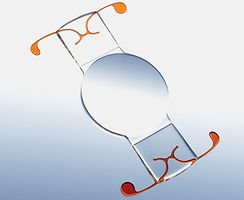

ACCOMMODATING IOL DESIGN
Accommodation occurs in the human eye where there is a change in the focal length, thus a clear image is maintained on the retina as an object is brought from far to near
With accommodative IOLs, pseudoaccommodation is where patients are able to have clear near vision despite the lack of accommodation
-
Based on the ciliary muscle contraction, capsule compression and therefore haptic compression to move the optic forward in order to provide focus at near
-
This IOL requires flexible haptics which enable the optics to move forward
-
Therefore, increasing the effective power of the eye.
-
-
The accommodative effect depends on:
-
The extent of axial displacement of the optic
-
IOL power
-
Higher powered IOLs have been known to have a greater accommodative range
-
-
Crystalens HD (Bausch and Lomb)
A single optic accommodating IOL, designed to provide a single focus on the retina.
-
This silicone IOL has a central bi-aspheric modication allowing:
- An increase in depth of focus
- Enhanced intermediate and near focus
-
In comparison with a monofocal lens, the Crystalens corrects both distance and near vision significantly
-
Problems with capsular contraction have caused a reduction in vision
-
This is as a result of the astigmatism induced by lens tilt
-
DUAL- OPTIC ACCOMMODATING IOLS
-
This design tries to adopt the optical changes during natural accommodation of the crystalline lens
Synchrony dual-optic accommodating IOL
A single piece of foldable silicone material
Designed to fill the entire capsule
-
The lens has a 5.5mm high plus powered anterior optic connected to a 6mm minus powered posterior optic via spring haptics
-
When focusing at near, the anterior optic of the IOL is displaced forward.
-
In order to provide stability in the centre of the capsular bag, the posterior optic has a wider surface area
-
The use of dual-optic IOLs has proved to show a reduction in the rate of PCO compared to single-optic IOLs along with partially resolving the symptoms of glare and halo problems

